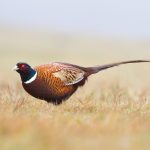This update to our 2022 Upland Gamebird Hunting Forecast incorporates the results of late summer upland bird population surveys. This data measures recruitment of birds into the fall population, providing a more finely tuned forecast than was possible at press time for the print magazine in mid-July.
Fall is in the air, and it’s time to nail down hunting plans!
The favorable mid-summer outlook fueled lots of excitement in upland gamebird hunting circles, particularly for pheasants in the heart of their range. The view from many of the state fish and wildlife agency upland gamebird experts was optimistic based on a mild winter, moderate to abundant populations of birds coming into the spring, and generally favorable spring weather. The data available at that time – pheasant crowing counts, spring quail survey results, and weather trends – represented a solid measure of what happened with last year’s production and an assessment of how birds made it through the winter; collectively, it was about half of the equation. As we have seen as recently as last year, extreme summer drought or too much precipitation at the peak of hatch can wipe out nests or broods and leave us with populations comprised of lots of adult birds – e.g., long-spurred wily roosters.
The best years of upland gamebird hunting across the nation’s heartland involve a pattern of mild winters followed by favorable weather conditions during the nesting season that result in excellent production of young birds. Given adequate habitat on the landscape, that one-two punch of good weather fortune yields memorable autumns.
The state fish and wildlife agencies that conduct August roadside surveys or other summer brood surveys measure what is truly most important to upland gamebird hunting success – the current year’s production – and the results of those surveys are released in September. This final piece of data can cement or upend the mid-summer projections. That’s why we tune up our Upland Gamebird Hunting Forecast prediction about this time each year by incorporating the results of those summer surveys.
So, what’s the updated story for 2022 based on these surveys?
It’s going to be an outstanding year to hunt pheasants in Iowa, Minnesota, North Dakota, parts of Nebraska and Kansas, and likely South Dakota! Bobwhite populations also spiked in Iowa and Nebraska due to favorable weather. There’s wide consensus that sharp-tailed grouse recruitment was greatly improved in the northern Great Plains, resulting in more young birds in the population. Finally, the chukar and Hungarian partridge hunting, while spotty overall, will be very good in some areas! Here’s the real-time outlook based on these key surveys. Pheasants are king among readers and there’s a lot to like about the prospects, so that’s where we’ll focus a big chunk of this update.
Quick Links
Sharptails, Huns, and Prairie Chickens
Pheasants
It will be another great year to hunt roosters in Iowa! Hunters tallied 373,000 pheasants last season, the best harvest since 2008, and it looks every bit as good this year. The roadside survey revealed a statewide pheasant index of 19.6 birds per route, almost identical to last year and 11% above the 10-year trend, according to Todd Bogenschutz, Iowa DNR. The highest pheasant abundance was in the Northwest (32 birds per route), West Central (30 birds), North Central (28 birds), and Central (22 birds) regions. Pheasant densities increased in the East Central and Southeast regions and were on par with last year’s results in all other regions. This matches the Iowa DNR’s weather model prediction of a stable to increasing pheasant population in mild winters followed by drier and warmer springs. The 2021-’22 winter statewide snowfall was 15 inches, which is 9.7 inches below the long-term average, and spring precipitation was slightly less than normal. In addition, thanks to a dry summer, the corn and soybean harvest was on schedule as of early September, which should help early season hunt success. The metrics all point to a solid campaign for pheasant hunters in the Hawkeye State. Bogenschutz predicts hunters will harvest between 300,000-400,000 pheasants this fall.
Bogenschutz says this fall should offer some of the best pheasant hunting in recent memory. “If hunters enjoyed last year, they should enjoy this year. Pheasant hunting will again be good for most of the state, with the best hunting being north of Highway 30. Bird harvest relies heavily on the number of hunters in the field and the past two years saw highest number of pheasant hunters since 2009, and that has translated into our increased harvests. The birds are there, so the harvest totals will depend on how many hunters return.”
Pheasant populations are also on the upswing in Minnesota. The 2022 range-wide pheasant index (48.4 birds/100 mi) increased by 18.4% compared to 2021 in which pheasant recruitment was impacted by drought. According to Tim Lyons, Minnesota DNR, the spring was cooler and wetter than average, but the timing of precipitation and a warmer and drier summer provided optimal breeding conditions. Pheasant populations increased in the Southeast, Central, and South Central regions, and were similar to last year in the other regions. Populations are above the 10-year average in the Southwest region as well as South Central and Central regions. Habitat conservation efforts are steadily increasing the amount of pheasant habitat in the state. Over 19,000 acres of habitat was conserved in the last year, including a Conservation Reserve Program enrollment increase of 12,000 acres. Minnesota’s pheasant populations are at or above the 10-year average in all regions, so it will be a good destination this fall.
In Nebraska, pheasant counts during this year’s July Rural Mail Carrier Survey were up by 26% compared to last year, according to the Nebraska Game & Parks Commission. Pheasant numbers increased by a whopping 48% in the Panhandle, the region with the highest pheasant abundance in the state in which pheasant numbers are 5% above the 5-year average. However, there’s a lot for eastern Nebraska hunters to like: Populations increased in the Northeast (+39%) and Southeast (+44%) regions. The Northeast now supports the third-highest abundance of pheasants by region in Nebraska at a whopping 43% above the 5-year average. Pheasant habitat in the eastern part of the state is localized, but pheasants are doing well in good habitat. This year the Southeast region received timely spring and summer rainfall which supported good pheasant production. The playa wetlands in the Rainwater Basin portion of the region continue to provide some of the best hunting opportunities, and many of those wetland basins were not flooded this summer, which creates more pheasant habitat. The downside for Nebraska rooster hunters is that pheasants continue to decline in the famed Southwest region (-6%). While the region still supports the second-highest pheasant abundance statewide, pheasant populations are now 34% below the 5-year average. The best bets this season for getting into good numbers of young birds will be the Panhandle, Northeast, and Southeast regions.
It’s a similar story in North Dakota where the rains returned this spring and summer after a wretched drought year in 2021. The roadside surveys conducted in late July and August, which involved 278 survey runs along 100 brood routes, revealed a 9% increase in pheasant populations, according to Jesse Kolar, North Dakota Game & Fish Department. The impressive average brood size of 6.2 chicks per brood is up 7% from last year, a sign of good recruitment. The pheasant numbers in the Northwest region look particularly good with 96 pheasants observed per 100-mile route, a 41% increase from last year, with an average brood size of six. In the Southwest region, surveys indicated 48 pheasants per route, down from 59 pheasants in 2021, with an average brood size of five chicks. Populations were up in the Southeast region at 39 pheasants per route, compared to 24 pheasants last year, with a brood size of five chicks. In the Northeast region, the region with secondary habitat and the lowest overall pheasant numbers, the surveys revealed 18 pheasants per route, down from 24 pheasants last year.
Kansas is a mixed bag this year. The state annually ranks as one of the top pheasant harvest states in the Nation and was coming off a solid harvest of over 338,000 pheasants in 2021. However, due to drought conditions, the summer roadside surveys revealed declining populations of pheasants in western Kansas, according to Kansas Department Wildlife, Parks, and Tourism. The good news is that the Smoky Hills of north central Kansas received excellent rainfall and the August roadside survey counts increased from last year. The Smoky Hills had the highest regional pheasant harvest last year and supported the highest roadside survey density of any region this year. The trick this year will be finding areas that had excellent cover in the spring and early summer, some of which may now appear a bit thin this fall due to late-summer drying. The highest pheasant densities in the Smoky Hills were recorded in the western and southern portions of the region. From a statewide perspective, it will be a year of good numbers in some areas and tough hunting in others, says Jeff Prendergast, Kansas DWP. “Drought conditions intensified in Kansas over the past year and had a marked impact on pheasant production across much of their primary range. This was most noticeable in the High Plains region of the western third of the state where there were ubiquitous declines. In portions of the North Central Smoky Hills region, spring precipitation was apparently enough to support a strong initial nesting attempt resulting in an overall increase for the region. However, this was not enough to offset losses in other regions.”
The wild card for pheasant hunters again this year will be South Dakota, the #1 pheasant harvest state in the Nation. South Dakota Game, Fish & Parks discontinued its long running August Roadside Pheasant Survey two years ago and now presents only a very general forecast. The annual pheasant harvest, which hovers around one million roosters, makes it crystal clear that the state will offer exceptional pheasant hunting each year. However, the lack of the August roadside survey data puts the burden on hunters to make their annual plans based on insights into weather and habitat conditions. Here’s the official report from South Dakota GFP for pheasant hunting prospects in 2022: “Pheasant populations have traditionally responded positively after a mild winter accompanied by normal spring and summer temperatures and precipitation. We can check those boxes across most of the primary pheasant range. Overwinter pheasant survival was likely excellent, and that means more nesting hens come spring. We expect increased pheasant brood survival because of the habitat cover from adequate early summer moisture. Overall, things are shaping up to have another great pheasant hunting season this fall in South Dakota.” My take on all of that is that it will be a good year to hunt roosters in South Dakota. Load up the bird dogs and go hunting!
SHARPTAILS, HUNS, AND PRAIRIE CHICKENS
It’s been a roller-coaster ride for prairie grouse in the northern Great Plains these last few years. In 2020, sharp-tailed grouse populations exploded in response to optimal spring and summer weather patterns, but then severe drought conditions last summer resulted in poor production of young birds according to the state fish and wildlife agencies. Last fall’s sharptail numbers were buoyed by carryover of adult birds from the previous year’s great recruitment, providing modestly good hunting in 2021. Now, in 2022, the switch flipped again with good spring and summer precipitation, leading to some results that aren’t exactly intuitive.
In North Dakota, the summer brood surveys revealed that sharptail populations were down by 30% from last year, with 13 sharptails observed per 100 miles. However, Kolar says that’s not the whole story from a hunting perspective; he expects that sharptail hunters will find more hatch-year grouse this fall due to the excellent breeding season moisture and better habitat conditions. Kolar suggests that hunters may need to adapt to hunting low-lying areas, particularly early in the season. “The rangeland vegetation is significantly taller, and there will be many more areas to search to find grouse. However, we have not had significant amounts of precipitation since mid-July so upland rangelands may not be as productive as hillsides or low-lying riparian areas. The sharptail densities were highest in the southwest, but the relative trends remain highest in the prairie potholes along the Missouri River.”
South Dakota looks like a great bet for prairie grouse this season. Hunters tallied 53,219 sharptails and prairie chickens last season, which was above the 10-year average, despite the rough drought conditions. This year is shaping up to be another big production year, according to South Dakota GFP. “Prairie grouse production is often correlated with the presence or absence of drought. Drought can deteriorate habitat conditions and reduce insect abundance, both of which can reduce chick survival. Last year, portions of the primary prairie grouse range were in a severe to extreme drought through much of the prairie grouse nesting and brood-rearing season. This resulted in below average prairie grouse production as habitat conditions continued to deteriorate through nesting and brood-rearing season. This year, the northernmost and central portions of the primary grouse range were drought free to abnormally dry and areas to the south and southwest witnessed moderate drought conditions. Only portions of Dewey, Ziebach, Stanley, and Haakon counties experienced a severe drought.” It remains to be seen whether the recruitment of young birds was as good as it was in 2020, but the weather patterns indicate that the heart of the prairie grouse range in western South Dakota will offer some incredible hunting opportunities this fall.
Hungarian partridge are typically viewed as a bonus bird in the bag in the U.S., but weather and habitat conditions have been favorable in recent years and there are now several states where hunters can specifically hunt partridge. North Dakota will be the prime destination for Huns this year based on the results of the summer brood surveys. Kolar reports that 12 Huns were observed per 100 miles, a whopping 46% from last year, with an average brood size of 10. To put it in perspective, the surveys revealed that Huns were on par with sharptail abundance statewide. This creates a new dynamic for upland gamebird hunters, according to Kolar. “Huns have rebounded, and the last time they were this good was in 2015. With partridge numbers looking impressive, there may be pockets where hunters could focus primarily on partridge.”
In Idaho, populations of Huns have been very good in the Southwest region over the last three years, according to Jeff Knetter, Idaho Department of Fish and Game. “Gray partridge numbers have been very good. Hunters can expect to find Huns in uplands near agricultural fields and in sagebrush/mountain brush near water sources. Gray partridge are typically found in Gem, Washington and Adams counties, and are expanding their range in Owyhee County.”
Huns also look promising in eastern Nevada. This year biologists in the Eastern Region recorded encounters with Huns during the summer months, according to the Nevada Department of Wildlife. A total of 24 adults and 164 chicks were classified for an impressive chick-per-adult ratio of 6.8:1. The best areas for Huns will be the Independence and Tuscarora Ranges and public lands around the flanks of the Ruby Mountains. In Montana, Huns aren’t surveyed but Montana Fish, Wildlife & Parks biologists expect some good partridge hunting in certain areas. The partridge harvest was above the 10-year average last year in the eastern half of the Northeastern Montana region, and Huns likely benefitted from favorable weather patterns this spring.
BOBWHITE QUAIL
Bobwhite populations are a mixed bag this year with quail trending upward in some states and at shockingly low levels in other.
Kansas will again offer some of the best bobwhite quail hunting in the country with survey results showing stable populations statewide. Drought conditions resulted in a population decline in the Southwest region, but quail numbers increased in the Smoky Hills and Flint Hills regions, according to Prendergast. “The drought conditions reduced production in the southwest region of the state, but quail increased on brood surveys through much of Northcentral Kansas and eastward. The modest increases across these regions offset the decreases observed in southwest to result in statewide densities equivalent to last year. Drought conditions will impact huntable cover throughout the range and will likely be more noticeable as you travel farther west in the state. The best opportunities will be in the Flint Hills and Smoky Hills regions of the state, with quality hunting opportunity scattered in the remaining regions.”
Nebraska also looks promising in that bobwhite numbers increased by 32% from last year on the July Rural Mail Carrier Survey, according to Nebraska Game & Parks Commission. Foremost, quail are up by a staggering 142% in the East Central Region, the #1 region for bobwhite abundance in Nebraska! The counts revealed a 58% increase in the Northeast region, but quail declined by 28% and 34%, respectively, in the Southeast and Republican regions.
In Iowa, quail rebounded impressively thanks to a mild winter and favorable spring weather in southern Iowa. The August roadside surveys revealed 0.81 birds per route, a doubling of the statewide bobwhite quail index doubled from last year’s 0.40 birds per route. This year’s statewide quail index is approaching the 10-year average of 0.95 quail per route. The survey results line up with Iowa’s DNR’s understanding of quail population response to weather conditions, says Bogenschutz. “This increase was expected given the lack of snowfall across southern Iowa, which lead to high overwinter survival. All southern regions reported greater than 100% increases in quail numbers over 2021 counts. The Southwest region reported the best overall quail numbers in 2022, followed by the South Central region. Hunters harvested 24,000 bobwhite last fall, thus this harvest figure could double this fall. Better counts in 2022 came from Adair, Adams, Fremont, Page, and Ringgold counties.”
In Texas, bobwhite populations are at essentially all-time low levels in most regions of the state due to drought. Notably, in the famous Rolling Plains region, the average number of bobwhites per route was 0.86 compared to 1.50 last year, well below the 15-year average of 12.10 bobwhites per route. It’s a similar story in the High Plains, Cross Timbers, and Edwards Plateau regions with averages of less than one quail observed per route in all three regions. However, in South Texas bobwhites observed per route was up from 3.10 last year to 5.26 this year, according to John McLaughlin, Texas Parks and Wildlife Department. McLaughlin says South Texas will be the place to go this season. “This year’s counts were still below our 15-year mean of 9.01, but the increase left us hopeful for the upcoming season. Because our surveys may have undercounted birds last year it’s tough to determine if abundance is truly up or down, but it’s likely hunters will have to temper their expectations this season in comparison. To that end, the late summer rainfall we received may benefit South Texas with its longer nesting season and should improve the outlook in the coming months. We expect average hunting conditions across the region, with certain ranches and counties outperforming our forecast as usual.”
Quail numbers look bleak in most of Oklahoma, according to Tell Judkins, Oklahoma Department of Wildlife Conservation. The August roadside surveys revealed 1.53 quail per 20-mile route, down slightly from 1.56 last year, and substantially down from the 10-year and 32-year averages of 3.08 and 5.22 bobwhites per route, respectively. However, Judkins says that anecdotally he has received numerous brood reports lately and that the August surveys have proven to not always be the most reliable when it comes to forecasting the season. Judkins says the Department’s October roadside surveys and upcoming 2022 Season Outlook will provide a better indication of what the upcoming quail season could have in store.
CHUKARS
The Intermountain West remained largely gripped in drought this summer but there were some bright spots in the most popular state for chukar hunters, so we focus the online update this year on Nevada.
In July and August, the Nevada Department of Wildlife conducted 41 surveys across key mountain ranges of the state that yielded some very helpful knowledge for chukar hunters in the Silver State. The calculated statewide average production value was 3.7 chicks per adult, which represents a 61% increase over the 2.3 chicks per adult observed last fall. While the statewide index is still considered low, there are some intriguing areas in northern Nevada.
The survey showed excellent production in Churchill County, particularly Hunt Units 181-182 (5.7 chicks per adult), which was indicative of good production that resulted from the monsoonal thunderstorms that provided excellent moisture in mid-summer. Likewise, the chukar numbers in Elko County were outstanding with high counts being recorded in Hunt Units 061/071 (6.6 chicks per adult), Hunt Units 066-068 (5.2 chicks per adult), and Hunt Units 074/081 (6.1 chicks per adult). The Nevada Department of Wildlife reports that Elko County chukar populations are on the upswing: “Consecutive mild winters have favored chukars in this part of the state. For less experienced chukar hunters and those hunters that don’t know the county well, Elko can be a challenge as birds can be distributed widely across the landscape. The Snowstorms, South Tuscarora Range, portions of the Independence Range and Bruneau River should provide quality chukar hunting this season.”
On the flip side, chukar numbers were very low in the drought-stricken mountain ranges of Washoe County and eastern Pershing County. Chukar numbers were modest and varied substantially in Eureka, Humboldt, Lander, and western Pershing counties.





